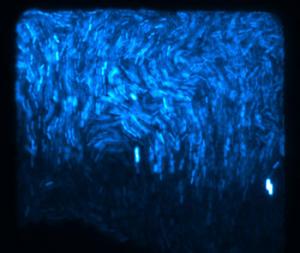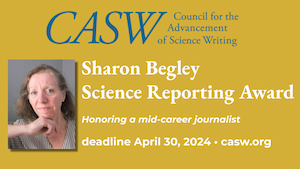PUTTING THE SIN — AND THE PROZAC YOGURT — INTO SYNTHETIC BIOLOGY. Synthetic biology has as yet no agreed-upon definition even among synthetic biologists. But it already has a nickname, as an event this week is making clear, that is somewhat unfortunate from the standpoint of public relations. The nickname: synbio.
The event was a report issued by 111 environmental and other organizations. They argue that synthetic biology is potentially dangerous and needs more oversight. At ScienceInsider, Elizabeth Pennisi summarizes the call they issued this week. At Patent Docs, Kevin Noonan goes into more detail about the organizations' press conference, the report they issued, and even lists all the participating organizations.
If you're not sure what the term "synthetic biology" means either, you won't get much help. The new report calls it "an extreme form of genetic engineering." Read on, but for now let's go with Pennisi, who says synthetic biology comprises
new biological techniques for building and remaking organisms for research and commercial uses ranging from medicines to biofuels.
At Cosmic Log, Alan Boyle provides additional detail, including a description of the synthetic biology project at the Woodrow Wilson International Center for Scholars, which is also worried about synbio's potential dangers.
Synthetic biologist Christina Agapakis's post at The Crux was published a few days before the 111-signatory report appeared, but it is for sure relevant. I am quoting it at length because she writes it well and is seeing synbio from inside.
She begins by describing the fallout from a previous blog post of hers, one about how an artist and designer named Van Balen developed an entirely fictional technique for engineering a bacterium to produce yogurt that contains Prozac. Her first post was syndicated at HuffPost, and you can perhaps guess the sort of stuff that led to. But let Agapakis tell it:
By the time its spread was complete, Van Balen, an artist interested in the implications of emerging biotechnologies, had mutated into a bioengineer at the forefront of synthetic biology research, creating Prozac yogurt in five days with just 860 base pairs of DNA. (If you were to actually make Prozac biologically, it would certainly take the action of many enzymes, each encoded by their own sequence of hundreds or thousands of base pairs).
Agapakis goes on to explain that the real synbio world is a lot more complicated (and a lot less far along) than these fabricated tales would have you believe.
Synthetic biology distinguishes itself from genetic engineering and the biotechnology of the past 40 years by promising that some day we will be able to sit down at our computers and type out what we want cells to do, hit “compile,” and a few days later, the DNA to do it will be mailed to us.
Not true, of course. Or at least not true yet. Still, she says, these futuristic fantasies creep into grant applications and discussion sections of papers.
The futures we imagine impact the way we pursue our research and the way we focus our limited resources.
Her message, aimed at both the 111 worried organizations and synbio's partisans:
Both extremes of hype surrounding synthetic biology, the threat of world-ending disaster on one end and the promise of solving all the world’s ills on the other...can prevent us from realistically and thoughtfully assessing the risks and benefits as well as the potential uses and long-term sustainability of new biotechnologies.
ONE YEAR LATER: FUKUSHIMA AND THE FUTURE OF NUCLEAR POWER. Cris Russell, at the Columbia Jurnalism Review's Observatory, wades through coverage of the anniversary of the Japanese earthquake and tsunami that, among other devastation and many thousands of deaths, severely damaged the Fukushima Daiichi nuclear power plant. She finds much gloom over the future of nuclear power.
Jessica Morrison, guest-blogging at SciAm, writes about her boss's anniversary Science paper reviewing what’s known and unknown about the behavior of nuclear fuel after a reactor accident. That would be Peter Burns, who directs a federally funded Energy Frontier Research Center. He also urges, ta-DAH, more research. At her SciAm blog Plugged In, Melissa Lott tells us what the US Nuclear Regulatory Commission says it has learned from Fukushima and why it has issued 3 new orders requiring additional safety equipment for all US nuclear reactors.
In his anniversary observance, Grant Jacobs posted several videos at Code for Life. You will be, no pun intended, blown away. At io9, Robert Gonzalez posts NASA's animation of the tsunami's gigantic spread in the 22 hours after the earthquake. It's based on satellite data.
At Dot Earth, Andrew Revkin posted an essay by physicist and longtime nuclear historian Spencer Weart exploring the physical and mental effects of Fukushima. It's not at all clear whether the radiation will cause a detectable increase in cancer years hence.
The psychological impact, however, is plain. Precisely because damage from very-low-level radiation cannot be detected, people exposed to it are left in anguished uncertainty. Many believe they have been fundamentally contaminated for life. They may refuse to have children for fear of birth defects. They may be shunned by others who fear a sort of mysterious contagion. Add onto this the dislocation from forced evacuation, and you have a recipe for social isolation, anxiety, depression, psychosomatic medical problems, reckless behavior, even suicide.
His forecasts are based on history; these things all happened after a worse nuclear accident, the one at Chernobyl in 1986. Weart traces the history of radiation fears, beginning in the 1930s. This item comes with a video, too: a trailer for the 1936 movie The Invisible Ray, featuring that dynamic duo, Boris Karloff and Bela Lugosi.
ENGINEERING HOMO SAP FOR CLIMATE CHANGE. Returning once more to our synbio theme, the most radical notion yet for coping with climate change caused a stir this week. The idea is to re-engineer humanity to help us adapt and so slow global warming by reducing consumption indirectly rather than directly. For example, giving people dark-adapted eyes, or making them smaller and/or allergic to eating meat. Leo Hickman summarizes the argument and extends it with additional interviews at The Guardian's Environment Blog.
At Watts Up With That, climate change denier Anthony Watts excerpts The Atlantic piece that triggered all the outrage. His hed is "Climate craziness of the week: Eugenics is making a comeback with climate optimized human engineering." And in the Department of Strange Bedfellows, from Grist, on the other side of the climate change argument, Sarah Laskow is just as horrified. Her hed is "Instead of hacking the planet, should we hack our babies?"
To all those hollering "eugenics!!!" I point out that human bioengineering has been going on for many years right under your noses. Consider, for example, the not-uncommon practice of choosing the sex of a future child. And what about prenatal diagnosis and preimplantation diagnosis of embryos? You people haven't been paying attention.
Still, I would bet that, despite the political problems in getting them adopted, conventional solutions like controlling carbon emissions would be less controversial, more practical, and cheaper ways of grappling with a warming planet. Faster, too, than engineering our own species.
Hey, here's a thought. Maybe the intent of the human engineering proposal is to be so alarming and nutsy — and abhorrent to both Right and Left — that it pushes climate policy in more sensible directions?

.png)

